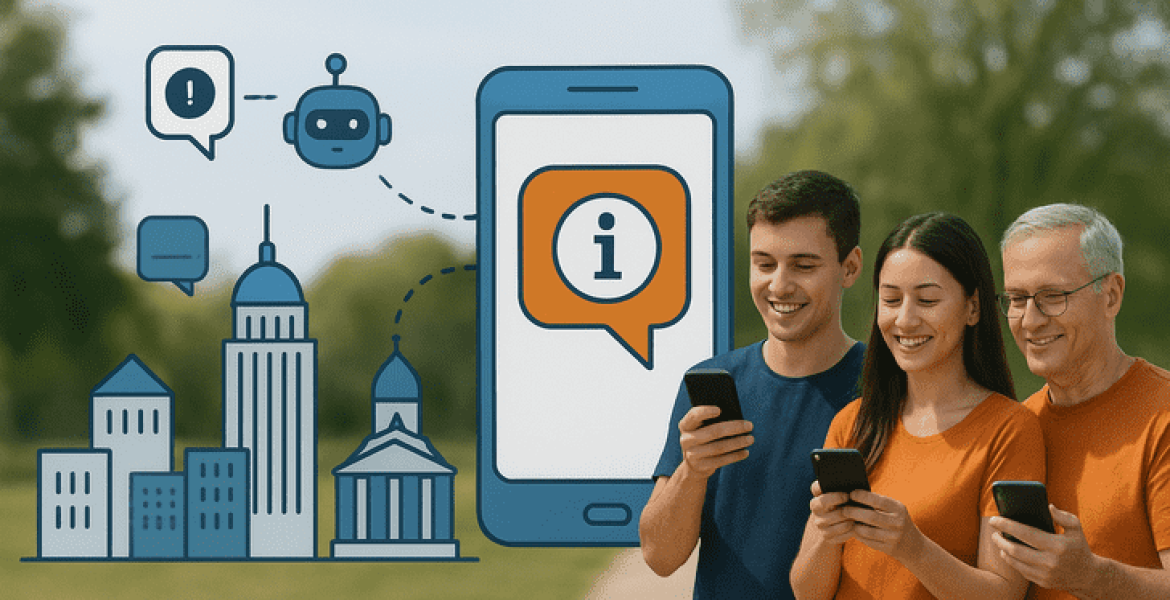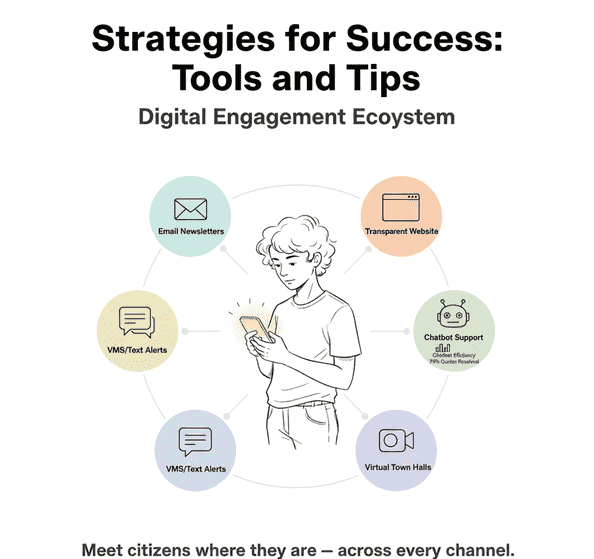

Local government is rapidly shifting toward digital solutions that make it easy for citizens to interact with their communities. Digital innovation from user-friendly websites to AI chatbots empowers these governments to provide 24/7 service, enhance transparency, and strengthen public trust. Studies confirm that citizen engagement is now a top priority for municipal tech leaders. Today, more than 97% of Americans own a cell phone and rely on mobile devices for everyday tasks. In Ohio, that trend is clear: villages and cities are embracing smartphone apps, interactive websites, and geo-targeted alerts to meet residents where they are.
Ohio is home to many small towns and villages, often with tight budgets and limited staff. Traditional channels local newspapers, flyers, and static websites no longer reach many people. For example, when a local Ohio newspaper closed, the village of Minerva needed a new way to share news. Minerva (pop. ~3,700) turned to a mobile app to reach residents directly.

This mirrors a broader trend: as local news fades and social media algorithms prove unreliable, communities need centralized, mobile-first platforms to keep citizens informed and engaged. In short, Ohio towns are finding that modern communication tools are essential to fill gaps left by older media.
Modern local governments have many tools to transform citizen engagement. Branded mobile and web applications act as one-stop portals for community updates, service requests, and even bill payments. These apps can send instant push notifications, SMS texts, or voice alerts for emergencies and community events, ensuring people get critical updates in real time. Many Ohio communities pair these apps with online 311 systems, so residents can report issues (like potholes or broken streetlights) and track responses in real time.
Another key innovation is geographic information systems. By mapping citizen feedback and infrastructure data, GIS lets officials see patterns and plan smarter improvements. For instance, GIS dashboards can highlight problem hotspots (e.g. frequent sewer complaints or power outages) and make that data transparent for both leaders and residents. In effect, interactive maps and data tools turn raw city data into a shared visual resource, which boosts local government community engagement by making issues visible and addressable.
Several Ohio municipalities are already leading the way with these technologies. Minerva’s Discover Minerva app, for example, offers direct links to village news, event calendars, job listings, and urgent SMS/voice alerts. Local officials report that the new app makes it easy for us to get the word out quickly and cut down on calls to the village offices. Similarly, Yellow Springs launched YSConnect, another mobile app that aggregates local news and alerts into one convenient tool. These apps have become central hubs for civic information, extending each city’s reach beyond traditional channels.
Beyond apps, many Ohio counties now run resident portals on their websites. These portals let citizens pay bills, submit permit applications, and track requests online. Local officials say these 24/7 services have raised satisfaction and dramatically reduced in-person visits. In practice, a village clerk might use portal analytics to improve services, or a city manager might see higher participation in a web survey. Together, these tools make government more responsive and accessible to everyone.
Investing in digital innovation yields concrete benefits for communities. First, it streamlines government work. Routine tasks like answering FAQs or processing payments get automated, freeing staff to focus on key projects. For example, one city found that after launching a custom app, calls to city hall fell by 30% because residents could self-serve in the app. Automated content updates keep information fresh as well: emergency alerts and event notices can be pushed instantly without manual edits.
Second, these tools improve equity and inclusion. About 15% of Americans rely solely on smartphones for internet access, so mobile-first design reaches younger, rural, or lower-income residents who might otherwise be left out. Features like multilingual interfaces and voice navigation ensure people of all backgrounds can get service. In fact, modern AI and automation features could bridge the digital divide, giving all citizens equal access to city services.
Finally, engaged citizens help cities plan better. Online surveys and 311 apps give officials real-time insights: mapping that data can reveal problem hotspots (e.g. an area with frequent pothole reports) so crews can act proactively. Publishing data openly also builds trust: cities with robust engagement programs report roughly 25% higher resident satisfaction than those relying on old methods. Each streamlined interaction like a quick text alert about a water boil notice reinforces confidence in local government and encourages people to stay involved.
Local leaders have several best practices to boost engagement. Multi-channel outreach is crucial: send announcements via email newsletters, SMS/text alerts, and mobile push notifications so everyone hears official news on their preferred platform. Social media and video are useful, too: a Facebook Live Q&A or a Twitter update can convey important news quickly in a conversational way. An App Maisters guide suggests tools like online polls, interactive surveys, and virtual town halls to gather input (for example, a quick web survey on a park improvement plan). Emerging tech like AI chatbots can answer routine citizen questions anytime; in one case a chatbot resolved 79% of resident queries on first contact, easing the load on staff.

Transparency is another key strategy. Make all information easy to find: publish budgets, meeting agendas, and project updates in clear language on your site. If rumors spread, correct them quickly through official channels. Always design with the user in mind a responsive, ADA-compliant site and clear menu structure mean people can navigate easily on any device. Finally, encourage two-way communication: allow feedback on city maps or apps, and use analytics to continuously improve the experience. These steps turn technology into genuine local government community engagement.
For Ohio’s mayors and city managers, the message is clear: digital transformation is not optional. Municipalities should approach digital transformation for local government as a path to smarter governance. App Maisters explains that such transformation modernizes citizen services, enhances data-driven decisions, and streamlines operations. In practice, this means making government meet citizens on their own terms online and on mobile rather than the other way around.
Citizen engagement isn’t a one-time project; it’s an ongoing partnership. By adopting mobile apps, interactive websites, and AI tools now, Ohio communities turn engagement into action. As App Maisters observes, local government community engagement is no longer a buzzword but a necessity for building trust. Each successful digital initiative whether a quick text alert about a road closure or a well-run virtual town hall amplifies the community’s voice.
Local officials and technology leaders can start small (pilot an app feature, run an online survey, or automate a single workflow) and build from there. Each step brings services closer to residents’ fingertips. With the right tools and strategies, Ohio municipalities can transform citizen feedback into real impact. By embracing public sector digital transformation, local governments can innovate and streamline their services. The time is now to embrace these innovations and build a more responsive, engaged local government for every Ohioan.
Citizen engagement means residents take part in decisions and stay informed about community needs. It helps leaders listen faster, and improve services for everyone.
Digital innovation makes service delivery faster and more personal. Mobile apps, modern websites, and online surveys give people access anytime without visiting city offices.
Public expectations have changed because most people use mobile first. Cities that transform early save time, reduce manual work, and respond quicker to residents.
Mobile apps, SMS alerts, GIS data dashboards, and self-service portals help a lot. These tools turn feedback into action and give leaders a live picture of what is happening.
Apps reduce call volume and give instant ways to report issues, pay bills, and receive news.They also build trust because people feel connected to the city daily.
Apps reduce call volume and give instant ways to report issues, pay bills, and receive news.They also build trust because people feel connected to the city daily.
Commodo elementum, sed imperdiet nunc euismod etiam aliquet viverra

App Maisters Inc is a Federal Government SBA 8(a) Certified and Texas Hub Certified company. We are a leading developer of high-performance mobile apps, websites, and enterprise solutions, that are specially designed to meet Federal, State, Local government agencies and higher education needs.
